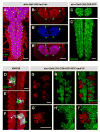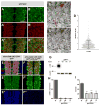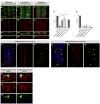Neuron-glia interactions through the Heartless FGF receptor signaling pathway mediate morphogenesis of Drosophila astrocytes
- PMID: 25033182
- PMCID: PMC4124900
- DOI: 10.1016/j.neuron.2014.06.026
Neuron-glia interactions through the Heartless FGF receptor signaling pathway mediate morphogenesis of Drosophila astrocytes
Abstract
Astrocytes are critically important for neuronal circuit assembly and function. Mammalian protoplasmic astrocytes develop a dense ramified meshwork of cellular processes to form intimate contacts with neuronal cell bodies, neurites, and synapses. This close neuron-glia morphological relationship is essential for astrocyte function, but it remains unclear how astrocytes establish their intricate morphology, organize spatial domains, and associate with neurons and synapses in vivo. Here we characterize a Drosophila glial subtype that shows striking morphological and functional similarities to mammalian astrocytes. We demonstrate that the Fibroblast growth factor (FGF) receptor Heartless autonomously controls astrocyte membrane growth, and the FGFs Pyramus and Thisbe direct astrocyte processes to ramify specifically in CNS synaptic regions. We further show that the shape and size of individual astrocytes are dynamically sculpted through inhibitory or competitive astrocyte-astrocyte interactions and Heartless FGF signaling. Our data identify FGF signaling through Heartless as a key regulator of astrocyte morphological elaboration in vivo.
Copyright © 2014 Elsevier Inc. All rights reserved.
Figures







Comment in
-
Astrocyte morphology is controlled by neuron-derived FGF.Neuron. 2014 Jul 16;83(2):255-257. doi: 10.1016/j.neuron.2014.07.005. Neuron. 2014. PMID: 25033173 Free PMC article.
Similar articles
-
Astrocyte morphology is controlled by neuron-derived FGF.Neuron. 2014 Jul 16;83(2):255-257. doi: 10.1016/j.neuron.2014.07.005. Neuron. 2014. PMID: 25033173 Free PMC article.
-
Lapsyn controls branch extension and positioning of astrocyte-like glia in the Drosophila optic lobe.Nat Commun. 2017 Aug 22;8(1):317. doi: 10.1038/s41467-017-00384-z. Nat Commun. 2017. PMID: 28827667 Free PMC article.
-
FGF signaling supports Drosophila fertility by regulating development of ovarian muscle tissues.Dev Biol. 2015 Aug 1;404(1):1-13. doi: 10.1016/j.ydbio.2015.04.023. Epub 2015 May 6. Dev Biol. 2015. PMID: 25958090 Free PMC article.
-
Drosophila gastrulation: identification of a missing link.Curr Biol. 2004 Jun 22;14(12):R480-2. doi: 10.1016/j.cub.2004.06.016. Curr Biol. 2004. PMID: 15203022 Review.
-
Fibroblast growth factor receptor-dependent morphogenesis of the Drosophila mesoderm.Philos Trans R Soc Lond B Biol Sci. 2000 Jul 29;355(1399):891-5. doi: 10.1098/rstb.2000.0625. Philos Trans R Soc Lond B Biol Sci. 2000. PMID: 11128983 Free PMC article. Review.
Cited by
-
Signaling Pathways Controlling Axonal Wrapping in Drosophila.Cells. 2023 Oct 31;12(21):2553. doi: 10.3390/cells12212553. Cells. 2023. PMID: 37947631 Free PMC article. Review.
-
Drosophila ClC-a is required in glia of the stem cell niche for proper neurogenesis and wiring of neural circuits.Glia. 2019 Dec;67(12):2374-2398. doi: 10.1002/glia.23691. Epub 2019 Sep 3. Glia. 2019. PMID: 31479171 Free PMC article.
-
The sulfite oxidase Shopper controls neuronal activity by regulating glutamate homeostasis in Drosophila ensheathing glia.Nat Commun. 2018 Aug 29;9(1):3514. doi: 10.1038/s41467-018-05645-z. Nat Commun. 2018. PMID: 30158546 Free PMC article.
-
A single-cell atlas of the sexually dimorphic Drosophila foreleg and its sensory organs during development.PLoS Biol. 2023 Jun 28;21(6):e3002148. doi: 10.1371/journal.pbio.3002148. eCollection 2023 Jun. PLoS Biol. 2023. PMID: 37379332 Free PMC article.
-
Origin of wiring specificity in an olfactory map revealed by neuron type-specific, time-lapse imaging of dendrite targeting.Elife. 2023 Mar 28;12:e85521. doi: 10.7554/eLife.85521. Elife. 2023. PMID: 36975203 Free PMC article.
References
-
- Araque A, Parpura V, Sanzgiri RP, Haydon PG. Tripartite synapses: glia, the unacknowledged partner. Trends Neurosci. 1999;22:208–215. - PubMed
Publication types
MeSH terms
Substances
Grants and funding
LinkOut - more resources
Full Text Sources
Other Literature Sources
Molecular Biology Databases

